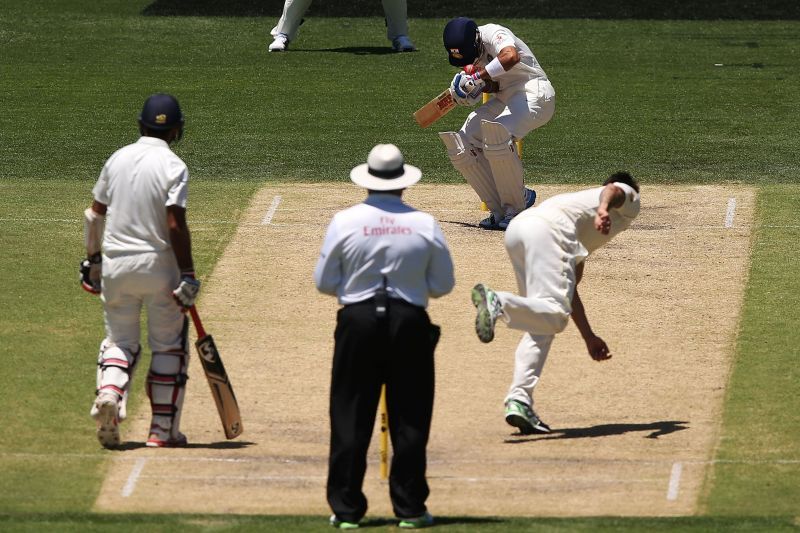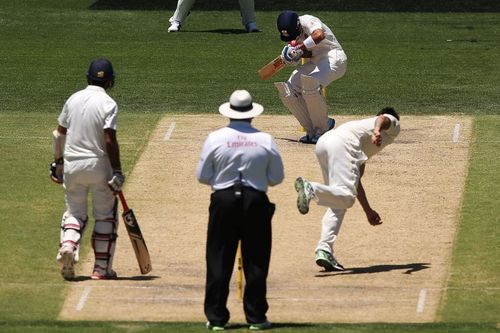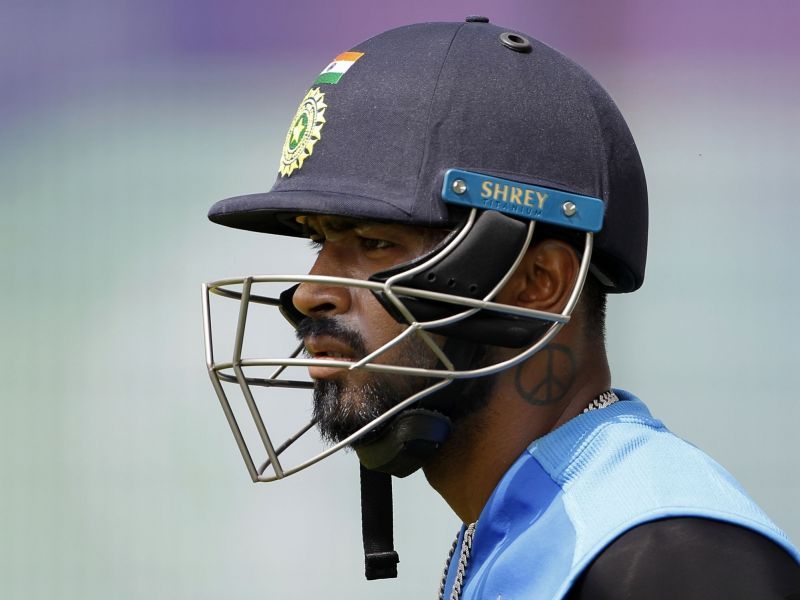
Jalandhar to England and back: How Shrey Sports have their helmets tested and delivered to Virat Kohli and other international stars free of cost [Exclusive]

The cricketing fraternity shuddered as Australian opener Phillip Hughes was struck flush on the side of his head - below his helmet - after missing an attempted hook during a 2014 Shield game.
He collapsed to the ground, suffering a cerebral haemorrhage, and went under the knife at a Sydney hospital almost immediately. But to no avail. The cricketing fraternity was rendered numb as two days later, on November 27, Hughes succumbed to his injuries - only three days shy of his 26th birthday.
Meanwhile, Shrey Sports were just a year into the helmet manufacturing business. They too were dealt a telling blow as the International Cricket Council (ICC) then mandated guidelines which helmets all over the world had to be based on. In essence, Shrey had to discard their existing models while working on the ICC-approved prototype.
But that is just the tip of the iceberg. Getting the helmet framework ready is always a long way from delivering the final products. The helmets – in a set of 200 – have to be sent to Loughborough University in England, where they are subjected to match balls thrown at 150 kmph. All 200 have to pass the test; the failure of even one results in the entire batch being rejected.
The fit-to-be-used ones then make their way back to Shrey Sports’ Jalandhar factory. Then comes the customisation part, wherein the makers cater to the specific and varied demands of the players. However, after all the taxing steps, the final helmets are delivered to the international cricketers free of cost.
Excerpts from Sportskeeda's exclusive interview with Shrey Sports CEO Raghav Kohli
![Shrey Sports CEO Raghav Kohli (R) with Punjab Kings captain KL Rahul (L) [Credits: Twitter]](https://statico.sportskeeda.com/editor/2021/06/106e6-16239207379858-800.jpg)
In an exclusive interview with Sportskeeda, Shrey Sports CEO Raghav Kohli elaborated on the methodology of helmet manufacturing, revenue generation, a few particulars of some of the world’s top cricketers and how Phillip Hughes’ tragic death shaped the entire business.
Excerpts:
You are the fourth generation in the sports equipment business. Could you please brief us about the formative years? What was the catalyst behind starting the business and when did you come into the fold?
My grandfather started BAS, and then my father started Tyka – they sponsored a couple of IPL teams with their clothing. Now I started this Shrey back in 2013, with the helmets.
You started this business in 2013 and Phillip Hughes passed away a year later. What all changes did you incorporate in your helmets after that unfortunate incident?
What happened was a lot of pressure came in from Cricket Australia (CA), Indian cricket board (BCCI), and lot of new rules came up, new safety standards, new testing measures – for example, earlier any player could use whatever helmet they wanted to. But now, the ICC on their website put up a list of approved helmets which players would have to use in ICC tournaments. They basically suggest cricketers around the world to use just those ICC-approved helmets.
Do players at the domestic level also need to use the ICC-approved helmets?
At the domestic and local levels, they [ICC] do advise that, but they cannot control that. But they do control the situation in any ICC tournament.
Shrey Sports have three categories of helmets and 18 types in total. How are they differentiated – in terms of both quality and pricing? Does weight of helmets differ, and if so, what is the significance of it?
Definitely, the weights are different. We use three different kinds of plastic for the upper shell and three different kinds of metal for the visor. So basically, if we talk about the cheapest helmet, that will have normal ABS [Acrylonitrile Butadiene Styrene] plastic shell and a mild steel visor which will be heavier. Because mild steel is obviously heavy. Then the middle range will have a better vinyl plastic shell and a stainless steel visor. Now stainless steel is little lighter. And then the top grade, which is used by all the international cricketers, has titanium visor which is approximately 20-25 percent lighter than all other helmets. So the difference between the cost of these plastics and metals is what comes down to the final price of the helmets.
Talking about the interior of helmets, what sort of padding is used?
Padding is usually similar in all the three models, we just give extra spares, do better foam in the top category – but it is mainly for cushioning purposes, it has got nothing major to do with safety. All the helmets are ICC-approved but the weights are different because obviously you want to have things which are lighter but stronger. So titanium is the lightest and the strongest helmet.
![Shrey Sports helmets are broadly classified into three categories - mild steel, stainless steel and titanium [Credits: Twitter]](https://statico.sportskeeda.com/editor/2021/06/79449-16239209005661-800.jpg)
There’s one material used called Koroyd, which I believe is imported from Monaco. Could you please explain the significance of it?
Koroyd is a honeycomb-like structure. It is a patented technology by a French company and they use it in the aircraft, they use it in the golf shaft, and the honeycomb-like structure makes this material very lightweight, very strong plus durable. So usually no other helmet brand uses any technology at all, they use traditional EPS (Expanded Polystyrene Foam) liner. But that is basically closed, that doesn’t allow any air to flow. But this Koroyd keeps the players cooler, plus it is lighter than EPS.
That’s why we don’t often see batsmen pressing their helmet against the skull and sweat dripping along the forehead?
Exactly, because our helmets are so lightweight and durable that they don’t need to pour the sweat out from their helmets all the time.
Shrey helmets are used worldwide. Could you please give us a rough estimate of how many countries and teams do you supply your gear to?
All the teams use our helmets, but not all the players. For example, in India, 10 out of 11 players use our helmets. You can see Virat, Shikhar Dhawan, KL Rahul, Hardik Pandya, Krunal Pandya, not Rohit Sharma. To name few of the famous guys, England captain Joe Root, he uses our helmets, Australian guy Steve Smith, South African David Miller. Then in IPL also, around 70 percent of the players use Shrey helmets.
And which particular type is most frequently used? Is it the Koroyd titanium one?
Koroyd was launched last year, so far Shikhar, Hardik, Krunal, Jadeja have shifted to Koroyd already. But a lot of other players do take time because this is a protective equipment and players are used to it. You know what I mean? Like the padding inside takes the shape of the head after a certain time, so it is not easy for the players to change something which is adjusted to their head shape. But I am pretty sure more players will make a shift soon whenever they get time to try the Koroyd.
Apart from these four guys, which is the helmet model majority of the players use?
Most frequently bought is obviously the cheapest helmet because not everyone can afford the titanium or stainless steel versions. So mostly it’s the lower model which is mild steel, the numbers are high there. But the weight difference between stainless steel and mild steel is not even 100 grams. Mild steel is obviously louder coated, the look is different. Stainless steel has its natural finish; it looks better, so it is expensive as compared to mild steel. But titanium is even more expensive because it costs 20 times more than stainless steel.
Can you give us the approximate weight of the three types?
Koroyd titanium is about 700 grams, masterclass titanium – which Virat uses – is around 730-740 grams, stainless steel is about 850 grams, and mild steel is about 900-925 grams. Not much difference, but then when you wear it on your head for a long time you feel it’s a lot. When you’re holding it, it might not feel heavy. But when you wear it, that difference also makes it feel quite a lot.
How many helmets does an international cricketer carry on a tour on an average?
Two now. Earlier they used to carry one, but the new rulings from ICC say if the ball hits once on your helmet, no matter if you can see the damage or not, you can’t use that helmet again. So these days, every player is carrying two helmets and we basically give them two helmets on every tour.
Are the helmets that take a hit discarded completely or do you guys take them back, repair and give them back again?
No, we never get them back. I think they just give those away to their fans or something, or they just leave them where they were. To be honest, we’ve never asked.
How are the deals struck? Do you sign contracts based on a team in its entirety or do you deal with individuals?
In the helmet business, there are no real deals in place. I know them [the players] personally, I am in touch with them personally. There are only two main helmet companies in the world – one is based out of England and one is us in India. So 99 percent of the players use between these two. So we send them the helmet, if they like it, they use it. It’s as simple as that.
Because the helmet market is not huge where you can pay money to the players to use your product. It’s a very specialised product - not everyone can make it, not everyone can get it approved. You need to send 200 helmets from each batch to Loughborough University. They put your helmet on a mannequin, they throw the ball at 150 kmph between the peak and the visor, and if one helmet fails – if the ball passes through one helmet – they fail the whole batch. Send 200 again, so it is very expensive and it is a very time-taking process.
![Shrey Sports manufactures a notional 500 helmets every single day [Credits: Twitter]](https://statico.sportskeeda.com/editor/2021/06/956cd-16239210610172-800.jpg)
Could you give us a rough estimate of the number of helmets Shrey Sports manufacture in a month?
On an average, we manufacture 500 helmets every day. This is for the whole world, not just for Indian market – for all the cricketers from America, Australia, South Africa, New Zealand, Sri Lanka, Bangladesh, India, England, everywhere.
When a deal is finally signed with the players, how is the pricing worked out?
We never charge, we give the helmets free of cost to all the international cricketers.
And what about the domestic players?
It depends actually. We have sponsorship guidelines in place. So any player who has played IPL or who has played for Indian cricket team, we never charge them money. Because this business works mainly on the relationships. But if, for example, there is a Ranji player who has never played IPL or for India, then we give them at least 50 percent discount.
If any club-level cricketer wants to buy your helmet, do they have to pay the full amount?
Yeah, you can buy from our website, you can buy from Amazon, Flipkart, our retail store in Bangalore - we have 20 outlets in Bangalore selling helmets.
So does the main revenue of Shrey Sports come from local players and sponsorship?
Not from the sponsorships obviously, from the ground level basically, from the common man.
Among the Indian players, who all are very picky and want their helmets made a particular way?
For example, Virat Kohli wants a shiny visor, so we do extra buffing for it, we spend a lot of time on it. He doesn’t like dull finish. Pujara would have his own customisation. But we can only play with the cosmetics, we cannot change the fittings because of the ICC regulations. So someone wants cushion, they want extra padding inside, someone wants shiny visor and things like that. Someone wants a yellow stopper band, the headband which you see touching the forehead inside the helmet. Like Virat wants that to be yellow in colour.
When Virat Kohli plays for India, he uses the navy blue-coloured helmet and the golden-coloured one while playing for RCB. So are the cosmetic changes made in the same helmet or are new helmets sent altogether?
We always make new helmets. So it’s not like if he’s used the helmet once he’ll return it to us, and then we’ll change the cloth and send it for IPL. We always send new helmets. The colours and logos are given to us by the RCB management, so they tell us about the colour of the fabric and logo, and then we know what customisations each player needs. We then send new helmets.

Are there players who visit your factory themselves to pick and choose the helmets?
There are only Punjab-level players. Like Mandeep Singh, he is based out of Jalandhar and he is a good friend, so he will visit me once in a while when he is in town. But a helmet is a helmet, it is not a bat really where you can customise while standing there. Helmet is made out of a mould, so you can only change colours, you can’t do much about it.
Talking about your factory, did Shrey Sports also suffer a financial crisis because of the COVID-19 pandemic? How did you deal with it?
As for financial crisis, we did suffer a little bit last year but as soon as the first wave was over, I think we did really well all across the world. Now from last two months, sales were obviously zero again but we are pretty sure once this lockdown opens, we will pick up again. But it is all manageable, we covered the sales when everything opened up. Because people were too frustrated sitting at home and they had not spent their money, and they wanted to go out and play, so I think that’s how we covered it up.